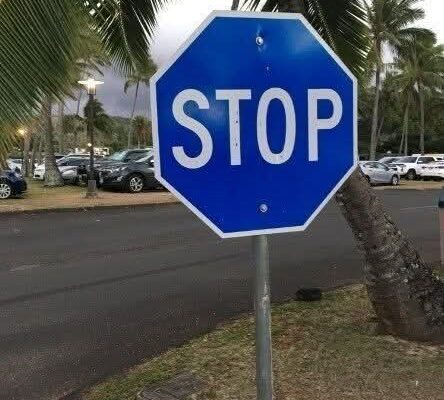Most drivers can instantly picture the iconic red, octagonal stop sign — a symbol so ingrained in our driving habits that it almost works on instinct. You see red, you stop. But every so often, someone comes across a blue stop sign and does a double take. Is it a mistake? A prank? A new traffic law no one told you about?
While they do exist, blue stop signs aren’t part of the official traffic system you encounter on public roads. In fact, in the United States, federal traffic regulations are crystal clear: all legal stop signs must be red with white lettering. The color choice isn’t random — red is one of the most visible hues to the human eye and is universally linked with danger and urgency. That’s why it works so well for prompting immediate action from drivers.
Blue stop signs, on the other hand, live in an entirely different world — private property. You might spot them in gated neighborhoods, on sprawling college campuses, inside amusement parks, or at large corporate parking lots. Their purpose is still to control the flow of traffic, but because they’re not sanctioned for public road use, they don’t carry the same legal authority as their red counterparts. Think of them as a courtesy request backed by whoever manages the property, rather than by the state or local police.
Here’s where the confusion sets in. Traffic sign colors have specific meanings:
-
Red: Stop or prohibition
-
Yellow: Caution or warning
-
Green: Guidance or direction
-
Blue: Information or services (like rest areas or hospital signs)
-
Black/White: Regulatory instructions
When a stop sign is blue, it’s breaking the color code. For someone used to the rules of the road, that’s like getting a text written in the wrong language — it takes you a second to process, which can be dangerous if you’re not paying close attention.
Still, just because blue stop signs aren’t “official” doesn’t mean you should blow through them. Failing to stop could cause an accident or land you in trouble with security or property management. While you won’t get a state-issued ticket, you could be cited under the property’s rules, lose access to certain areas, or be held liable for any collision.
In some cases, blue stop signs are chosen deliberately to match a community’s aesthetic or branding. A luxury resort, for example, might opt for a softer color palette to blend with landscaping, while still signaling where drivers should come to a halt. In other words, they might look different, but the intention behind them remains exactly the same — keeping vehicles, cyclists, and pedestrians safe.
So if you ever encounter a blue stop sign, treat it no differently than you would the traditional red one: stop completely, check your surroundings, and proceed only when it’s safe. Whether the law demands it or not, the principle is the same — safety on the road, or even a private driveway, is worth more than the few seconds you might save by ignoring it.
Because in the end, it’s not really the color of the sign that matters. It’s the pause you take that could prevent something far worse from happening.



